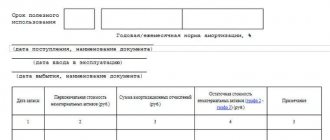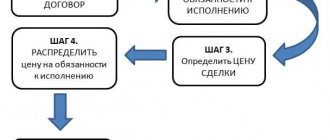How is the receipt of proceeds from sales into the current account reflected in accounting?
In practice, most often, proceeds from sales are transferred to the company's bank account via non-cash means.
Counterparties pay for the goods received (products, semi-finished products, services, etc.) by the usual transfer of funds from their current account to the seller’s current account. This is the simplest, most economical and safest way to transfer proceeds to the company’s account. How to record an operation in accounting if non-cash proceeds from sales are received in the current account - what entry should be used for this?
At the time of shipment, the seller reflects the proceeds from the sale of goods (works, services) and the buyer’s receivables. This debt is paid off as soon as the money from the buyer arrives in the seller's account. The following entries are made in accounting:
Postings for recognizing revenue in accounting are made on the basis of shipping documents (invoices, acts, etc.). A document confirming the receipt of money into the account is a bank statement.
When reflecting the receipt of revenue in foreign currency into a bank account, account 52 “Currency accounts” is used instead of account 51 “Currency accounts”.
Learn about the nuances of accounting for foreign currency account transactions in this article.
Methods for receiving funds to the organization’s current account
Funds can be transferred to the company’s current account in one of the provided ways, among which are the following:
- transfer from a current account to another organization or individual entrepreneur;
- through the terminal from other companies and individuals;
- via bank cards;
- from the budget and extra-budgetary funds.
in cash from the cash desk of another organization or individual entrepreneur;
The following can be identified as supporting documents for non-cash payments: payment orders, demands and orders, letters of credit, collection orders, and checks.
Cash proceeds handed over to the bank: what entries to make in accounting
It is not always possible for a company to work exclusively with non-cash revenue. If the proceeds from customers are received in cash and the cash balance exceeds the established limit, the excess amount must be deposited into the current account.
We explain how the cash limit is set in this publication.
Cash proceeds from the cash register are transferred to the current account - what kind of entry can be used to record this operation?
The operation of depositing proceeds into a current account is accompanied by the execution of cash documents (cash expense order, announcement for cash deposits, etc.) and is reflected in accounting by posting:
If the proceeds are not delivered to the bank by a company representative (cashier or other authorized person), additional entries may be required.
Find out what operations are available when your account is blocked here.
By debit
In accordance with the current plan, debit 51 transactions characterize credits to the enterprise's account. In accounting documentation, such transactions are indicated by postings to other accounts.
In this case, 51 acts as a correspondent. The amount that is credited to the account is debited from another source and added when accounting for credit. Payment purposes may vary, so you should consider the most common options.
Table 1. Operations by Dt.
| Number | Name |
| 50 | Receipt from the cash register |
| 51, 52, 55 | Receipts from other company accounts |
| 57 | Receipt of funds previously listed as in transit |
| 58 | Accruals received as a result of repayment of the loan provided |
| 60, 62, 68, 69, 73 | Crediting of funds received as a result of repayment of debts from buyers, contractors, customers |
| 67 | Obtaining credits and loans |
| 80 | Credits from friends in the form of deposits |
| 86 | Receipt of funds from third parties or outside organizations for the purpose of financing |
| 90 | Crediting proceeds from the sale of goods, provision of services, performance of work |
| 91 | Crediting funds received as a result of the sale of the organization’s property |
| 99 | Receipts arising from emergency situations |
In general, correspondence for item 51 with other accounts allows you to accurately reflect the movement of funds and indicate the content of the transactions through which they were credited to the account in the bank.
About maintaining an account. 51 watch video:
When additional entries are required to reflect the receipt of revenue into the current account
Proceeds from the company's cash desk can go to the current account through a special intermediary (bank collector). If the proceeds are handed over to the bank through a collector, what additional posting may be needed?
In this case, an additional entry appears in accounting, taking into account the presence of cash proceeds “in transit” from the cash register to the current account. The appearance of a collector in the chain of movement of proceeds from the cash desk to the bank requires recording the following set of transactions in accounting:
Additional posting to reflect revenue “in transit” is required in one more case: if the company’s cashier hands over the revenue to the bank through the terminal - read more about this below.
We will tell you in this article how to register the transfer to the current account of the authorized capital.
How to process the revenue of an online store if the buyer paid for the order with a card? The answer to this question was given by ConsultantPlus expert T. Bursulaya. If you do not yet have access to the system, get a free trial online access and find out how to make entries for an online store accountant.
The proceeds were credited to the account through the terminal: we are sorting out the transactions
Banks can provide companies with a self-collection service. This method of transferring proceeds to a current account can significantly reduce the time between receiving cash proceeds and its crediting to a bank account.
Instead of making a daily trip to the bank to deposit cash, the teller deposits it into the bank terminal. To use this service, the company enters into an agreement with a banking institution and receives a special access code, which is entered into the terminal when depositing cash.
The proceeds deposited through the terminal almost immediately go to the company’s current account (minus the commission). A doubt may arise: is this extra posting necessary using account 57 “Transfers in transit” if the money goes straight to the account?
Wiring is still required. The terminal may not accept all banknotes in full, so to reflect the transaction of transferring proceeds to the account, it is safer to use account 57 “Transfers in transit.”
The wiring diagram in this case will be similar to that described above (when money is transferred to the bank through a collector). But the content of the operations will be somewhat different:
After accepting the proceeds, the terminal issues a document confirming the receipt of cash (order check, receipt, etc.).
Should I include in the revenue the tips that the client left to the waiter (or maid) after paying with a card, and is it necessary to withhold personal income tax from them? The answer to this question is in the ConsultantPlus system.
Get free trial access to K+ and watch the full version of the explanation.
This material will introduce you to other transactions on the current account.
By loan
The approved accounting plan provides for keeping records of transactions that are accompanied by the write-off of funds from the account. The activities of any organization or enterprise are always accompanied by such operations. By posting Kt on 51, the write-off of funds and their further movement are recorded.
Table 2. CT operations.
| Number | Name |
| 50 | Withdrawing funds from a bank account |
| 51, 52, 55 | Transfers of money to other bank accounts registered in the name of the organization |
| 57 | Transfer of funds that were not credited for the approved purpose |
| 58 | Financial investments and loans |
| 60, 62, 68, 69, 70, 73 | Debt repayment |
| 80 | Return of deposits to partners after the expiration of the agreement |
| 81 | Redemption of own shares and shares |
| 84 | Covering expenses associated with holding events approved by the decision of the founders |
| 86 | Compensation of costs associated with targeted activities |
| 99 | Write-off of funds to cover uncompensated expenses caused by emergency situations. |
51 can also be used to reflect non-cash payments to employees and other personnel.
The following operations can be recorded:
Monthly salary payment- Accrual of bonuses, allowances, bonuses, vacation pay
- Payment of financial benefits, compensation, sick leave
- Transfers to the Pension Fund and insurance organizations
- Payment of expenses caused by the economic needs of the company's employees
- Expenses associated with business trips of employees
Table 3. Examples of postings.
| Debit | Credit | Description | Confirmation document |
| 70 | 51 | Payroll transfer to employee accounts | Money orders |
| 51 | 69 | Receiving excess funds accrued to the insurance fund and the Pension Fund of the Russian Federation | Statement from the bank |
| 71 | 51 | Providing funds to employees to meet business needs | Payment order |
| 51 | 73 | Crediting funds as compensation for damage or covering shortfalls | Bank statement |
Thus, 51 has a wide range of applications. It can be used to record numerous transactions. On the other hand, the multifunctionality of such an account sometimes leads to errors when preparing reports. Therefore, it is necessary to consider application examples.
Examples of operations on video:
Results
To reflect the receipt of revenue into a bank account, accounting entries are made to the debit of account 51 “Currency accounts” (52 “Currency accounts”) and the credit of account 62 “Settlements with buyers and customers.”
If cash proceeds are handed over to the bank by a cashier, account 50 “Cash” is credited in correspondence with account 51 “Cash Accounts” debited. When intermediaries (collectors, terminals) participate in the transfer of proceeds from the cash desk to the bank, account 57 “Transfers in transit” is additionally involved in the postings. You can find more complete information on the topic in ConsultantPlus. Free trial access to the system for 2 days.
Score 51
The company's activities involve numerous financial transactions. Cash turnover occurs both through cash from the cash register and through non-cash transactions. In the second case, the company opens a current account (s/c) with a bank in order to conduct non-cash transactions with individuals and legal entities.
Non-cash transactions are used for:
- Purchases of materials, raw materials, finished products
- Payment for services
- Paying taxes
- Accrual of payments to employees provided for by law
- Providing or repaying loans, credits
- Compensation for damages
- Receiving contributions for financing
- Revenue deposits
- Covering current one-time or regular costs
The main purpose of account 51 is to summarize information regarding the availability and flow of funds on the account of an enterprise opened with a credit institution. The account and instructions for its use were approved by order of the Ministry of Agriculture of Russia No. 654 (dated June 13, 2001).





